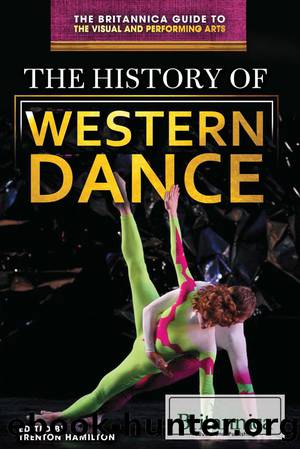The History of Western Dance by Trenton Hamilton

Author:Trenton Hamilton
Language: eng
Format: epub
ISBN: 9781680480801
Publisher: Britannica Educational Publishing
Published: 2015-07-31T00:00:00+00:00
Merce Cunningham and Carolyn Brown rehearse Cunninghamâs ballet Second Hand in 1969. The postmodernist ballet had no set decorations and the dancers wore costumes that were designed by American artist Jasper Johns.
POSTMODERNISM
During the 1960s and â70s a new generation of American choreographers, generally referred to as postmodernist choreographers, took some of Cunninghamâs ideas even farther. They also believed that ordinary movement could be used in dance, but they rejected the strong element of virtuosity in Cunninghamâs technique and the complexities of his phrasing and structure, insisting that such a style interfered with the process of seeing and feeling the movement clearly. Consequently, the postmodernists replaced conventional dance steps with simple movements such as rolling, walking, skipping, and running. Their works concentrated on the basic principles of dance: space, time, and the weight and energy of the dancerâs body.
Postmodernists discarded spectacle as another distraction from the real business of movement. Costumes were often ordinary practice or street clothes, there was little or no set and lighting, and many performances took place in lofts, galleries, or out-of-doors. Narrative and expression were discarded, and the dance structures were usually very simple, involving either the repetition and accumulation of simple phrases or the working through of simple movement games or tasks. In Tom Johnsonâs Running Out of Breath (1976) the dancer simply ran around the stage reciting a text until he ran out of breath.
Most avant-garde modern-dance companies have been quite small and have occupied a position on the fringe of the dance world, attracting only small and specialist audiences. Although mainstream modern dance now attracts large audiences in both Europe and North America, it too was for many decades a minority art form, often playing to only a handful of spectators. Modern-dance companies were then, and still are, relatively small. Partly because they lack funding, they tend to use less elaborate costume and staging, and they perform in small theatres where contact with the audience is close.
Download
This site does not store any files on its server. We only index and link to content provided by other sites. Please contact the content providers to delete copyright contents if any and email us, we'll remove relevant links or contents immediately.
| Architecture | Art |
| Music | Performing Arts |
| Photography |
Rule by Jay Crownover(2641)
The Meaning of the Library by unknow(2486)
Fierce by Aly Raisman(2140)
Star Wars The Rise of Skywalker The Visual Dictionary by Pablo Hidalgo(1829)
Our World by Mix Little(1813)
Fashion 101 by Erika Stalder(1792)
DRAW: A Fast, Fun & Effective Way to Learn by Jake Spicer(1546)
The Hunger Games: Official Illustrated Movie Companion by Egan Kate(1373)
Charlie and the Chocolate Factory (Puffin Modern Classics relaunch) by Roald Dahl(1360)
Beyond the Dance by Chan Hon Goh(1313)
Monster Book of Manga Drawing by David Okum(1247)
Forward: A Memoir by Abby Wambach(1195)
1787 by Nick Brodie(1190)
The Maddie Diaries by Maddie Ziegler(1182)
Origami for Children by Mari Ono(1162)
Friends Lovers and Family by Unknown(1139)
Thirteen by Kelley Armstrong(1108)
Harlem Stomp! by Laban Carrick Hill(1105)
Ashes and Ice by Rochelle Maya Callen(1101)
